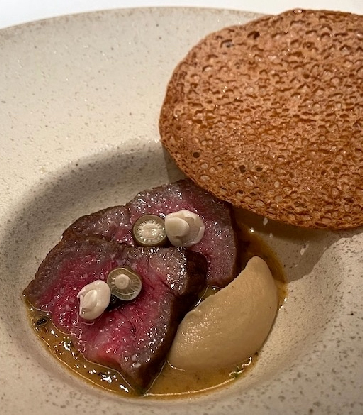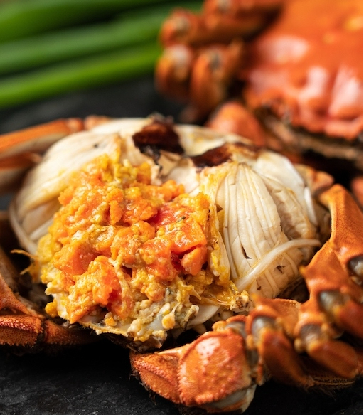How did a Korean chef like you end up cooking Thai food?
Growing up, I didn’t really decide to become a chef, and my association with Thai food began by chance. I’m someone who gets easily bored – a trait that I’ve had since I was young – which is both good and bad. It meant that I was curious about things, but also meant that I was unfocused in some ways. However, Thai cuisine is one of those things that I have never been bored by ever since I fell in love with it.
One day, at the end of my military service, I was watching a TV program where the cast ate Thai bird’s eye chili as a penalty. When I saw the cast members shedding tears because it was too spicy, I became curious about how it actually tasted. The ingredient fascinated me. After that, I decided to learn more about Thai cuisine. It was as if I was possessed by something. In fact, on the third day after my discharge from the military, I went to a Thai restaurant for a job interview. I still remember printing my resume and holding it with both hands very carefully for fear of wrinkling the piece of paper. At that point, I had never learned how to cook and had no previous experience. I decided that if I was rejected, I was going to ask the chef to let me work and learn there without pay.
Luckily, I eventually got a job at a Thai restaurant in the central district of Seoul. Not only was the chef Thai, but four of the seven kitchen crew there were also Thai and spoke mostly in Thai. At that time I couldn’t speak the language, so I ended up doing kitchen chores and errands. I was so frustrated by this language barrier that I decided to learn Thai. It was hard at first, but I learned to speak it and began to use some Thai words when speaking my colleagues. Being able to communicate with them made me excited to learn more, and I put in more effort into my study of it so that I could progress to speaking in full sentences. That was real improvement! The chef also appreciated my passion, and soon after I was able to learn how to cook the food instead of carrying out tedious errands.

Do you visit Thailand often?
I started learning how to cook in Thai restaurants in 2003, but at that point, I had never been to Thailand before. After about two years, I thought I should go to Thailand, so I took a trip there. When I arrived at the airport, I breathed in the humid air and I thought, "I'm finally in Thailand." During the taxi ride from the airport to downtown Bangkok, I was so excited to speak to the driver while the Thai language skills that I had accumulated. It was my first time there, but I felt as if I had visited it many times before. I was very happy and excited, it felt like I was someone who had fallen in love.
Things have improved now, but in the early 2000s, it was difficult to find a proper Thai cookbook or a good Thai chef in Korea, so it was very important to travel there, meet the people, eat the local food, and go to a bookstore to get Thai cookbooks. All the notes, pictures, and videos of the food that I ate during my travels all over Thailand had become ingrained in me, almost as if they had become my flesh and blood. After that first trip to Thailand, I have visited the country more than once a year for 15 consecutive years. This year I was unable to go because of the pandemic. I really miss Thailand!
What did you learn from visiting Thailand, and what do you think is the charm of Thai cuisine?
Thai food is just delicious, there is no doubt about it. Even the most unpalatable dishes at a restaurant there will be eaten by the customers due to one of the defining characteristics of Thai food: the concept of seasoning food with many condiments made available at the table.
Even though there are various spices in Korea, it does not really compare to the numerous herbs and spices that abound in Thai cuisine. When you eat out in Thailand, there can be up to 10 condiments on the table including sugar, red pepper, fish sauce and dried shrimp. I’m not talking about special occasion restaurants; it’s just like that wherever you go. The diner can add seasoning to their food according to their individual tastes and moods. Once you gain a bit of understanding about the basic tenets of Thai food, you realize that there is space for you to express your creativity.
I haven't officially learned cooking at any institution. Instead, when I went to Thailand to taste real Thai food and to observe how people work in the kitchen, I wanted to learn more about all the ways of cooking and handling food ingredients. I had always asked myself why something was always done a certain way, and in Thailand, I went looking for answers. I thought that there must be a reason why the shape of the wok is flat or deep, how the size of the cooking utensils affected cooking, whether people were working diligently, or were lazy. Every single behavior of a chef becomes important because it all melds into their cooking.
There are also ways of preparing food that I only found out about when I was in Thailand. For example, now I intentionally cut the meat for pho noodle soup with a blunt knife, which is hard to use. If you think about it, a sharp knife would be better for cutting meat neatly, but I observed that there was a unique way of cutting meat in Thailand. Instead of slicing it nicely into pieces, they roughly ripped the meat. This is one reason why I visit the country. These subtle cooking habits can create a big difference and make the food more authentic.
Thailand feels like home to me. Maybe I had a link with the country in a previous life. Whenever I think of Thailand, I think of the people and the food, and it makes me think of comfort and friendliness. I want to cook the way the Thai people cook, and I want to showcase Thai food and put my own spin on it.

What helped you improve as a Thai cuisine chef?
In 2009, I started working as the head chef of a Thai restaurant called Saint-Augustine. I introduced soft shell crab curry, or boo paht pong karee, onto the menu and it was a big hit with customers. This menu was a sensation and became extremely popular, which led to the restaurant expanding into a franchise of nearly 50 branches all over South Korea. I became the chef director and developed the menu for the entire franchise.
At that time, soft shell crab was rarely imported into South Korea. When our menu become a phenomenal success, our customers consumed about 80 percent of the nation's soft shell crab supply. Later, we even started importing the crab ourselves. This meant that we could open up possibilities to introduce it as an ingredient and contribute to its acceptance in the South Korean market. As a chef director, my work became more diverse. I went back and forth between Thailand and South Korea. I hired Thai people and brought them to South Korea, trained them, and developed the menu. I was even involved in the import business while trying to source ingredients. This way, I became armed with a whole range of hands-on knowledge.

Why did you open Kunsomchai as a chef owner?
After helping to popularise Thai food amongst the Korean public, I aspired to open a space to showcase lesser-known Thai food. I wanted to make a restaurant that people could visit whenever they wanted to discover truly authentic Thai food. I wanted to introduce customers to the endless charm of Thai cuisine. It is so much more than just pad thai or tom yum kung, both of which are well known in South Korea. For example, people are still unfamiliar with massaman curry, a dish that combines curry from southwestern India and curry from Thailand, but once you taste it, it makes them realize that it is worth visiting the restaurant again.
Most of all, I wanted to make my own original dishes that are reinterpreted in the Kunsomchai way. Most foreigners only know about bibimbap that is seasoned with gochujang (fermented red pepper paste), but Koreans also make bibimbap with ganjang (soy sauce) or doenjang (soybean paste) and sesame oil. Adding these sauces instead of the typical gochujang does not undermine the identity of Korean food, but rather creates diversity in the food. The same goes for Thai food. It is commonly known that traditional Thai recipes have certain combinations of spices, but there are many different variations that put a twist on it! It is my wish that Koreans can experience the authentic taste of Thailand, and that Thai people can experience familiarity and creativity when they eat my food.
What are your aspirations for the future?
Compared to 20 years ago, Thai food has become very popular in Korea, but there is still a lot of potential for development. Our restaurant doesn't serve pad thai or som tam (green papaya salad), which are dishes that are the most well known in Korea. I don’t want to limit Thai food to just these dishes, because when I list them on the menu, people end up ordering familiar dishes without looking at the rest of the menu. A chef can be a good guide for guests to try new food when they have never tried it before. There are too many wonderful flavors that one can explore. That's why I tend to encourage people to be more adventurous. We serve a chef’s tasting menu without detailed explanations and authentic menus that can’t be easily found in other restaurants such as tom sapp soup, khao soi, and pak boong fai daeng.
I hope Kunsomchai can be a place to visit whenever an adventurous foodie is curious about trying new Thai cuisine. I try to cook something that will surprise my guests whenever they come. Some of our regular customers let me cook whatever I want – a true omakase experience! They trust me with everything from the ingredients to the cooking method. Then I go to the market, pick out the best ingredients for the day, and cook dishes that are not on the existing menu. This process is always an exciting and enjoyable one for me. I want my guests to experience Thailand’s culture, food and even its warm breeze in Kunsomchai.





















